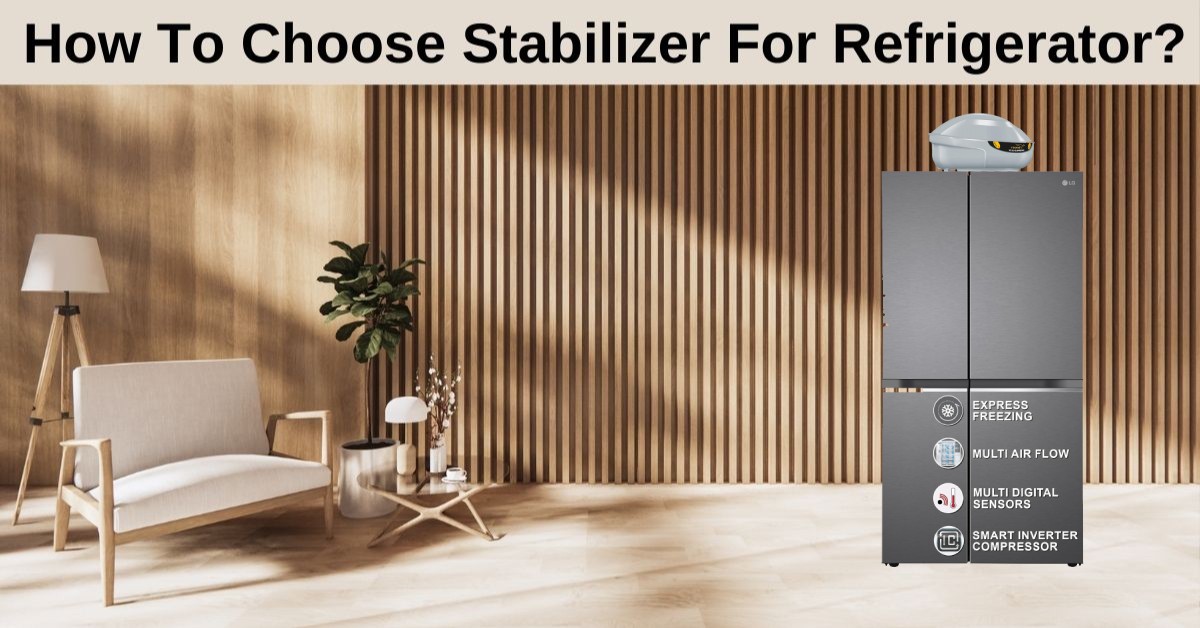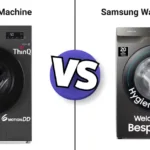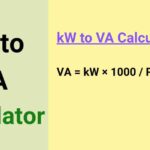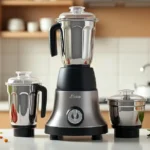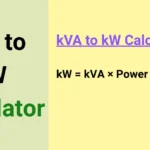The voltage changes are inconsistent, and such surges can be extreme and may spoil the electrical appliances within the house, particularly the refrigerator.
A stabilizer is like some form of insurance for your refrigerator, protecting it from high-voltage overload and ensuring that your appliance works efficiently.
But with different makes and models, what criteria does one follow to be able How to Choose Stabilizer for Refrigerator?
When it comes to the most dependable equipment such as fridges the voltage stabilizer again lies on top as it helps prolong its life even when there are power fluctuations.
Are you worried on how to as such how to choose and order such a stabilizer for your refrigerator? The following sections will include some of the key aspects and advantages of stabilizers that will help you to become more informed when choosing the appropriate one of the best stabilizers for your refrigerator.
What is a Voltage Stabilizer? How Does It Protect Your Refrigerator?
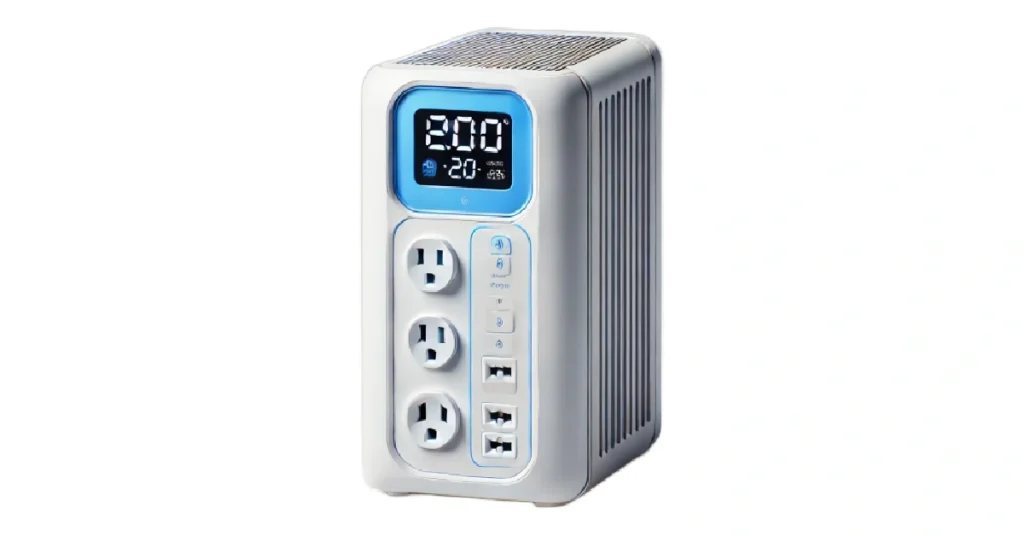
The voltage stabilizer is an electric device used to stabilize your appliances’ voltage.
If the power supply level in your house dips too low or too high, don’t worry as the stabilizer can keep the level within the range that the refrigerator can withstand.
#1. Here’s how a stabilizer works:
#1. Voltage Regulation:
The input voltage is preconditioned and regulated by the voltage stabilizer at all times.
If the voltage is reduced or increased compared to a pre-established threshold value, the stabilizer reinforces all measures aimed at restoring it to the pre-established value, starting with reducing it.
#2. Surge Protection:
This protection device also provides safeguards against any sudden occasional spikes of voltage that could lead to a short circuit.
#2. How does it protect your refrigerator?
#1. Compressor Protection:
This, perhaps, is the most costly and fragile of all the components of these refrigerators, the compressor, apart from the high-quality compressor.
Any extremes in voltage are, thus it, this unit can malfunction, or get damaged. A stabilizer guarantees that the voltage supplied to the compressor shall not be less or more than.
#2. Maintains Cooling Efficiency:
Temperatures often come short like the refrigeration appliance when hygiene standards are at least important. Without steady voltage, A stabilizer ensures steady power, leading to consistent cooling performance.
Why Use a Voltage Stabilizer?
While some newer refrigerators may come equipped with basic in-built protection mechanisms, they are often not robust enough to handle extreme fluctuations, especially in regions where voltage surges are common.
Here are the key reasons why you should use a voltage stabilizer for your refrigerator:
#1. Protects Against Fluctuations:
Inconsistent voltage can drastically reduce the lifespan of your refrigerator. A stabilizer ensures stable voltage, preventing potential damage.
#2. Prevents Compressor Burnout:
Frequent power fluctuations cause the compressor to work harder, which can eventually lead to burnout. A stabilizer reduces this strain, increasing the life of your compressor.
#3. Maintains Appliance Efficiency:
Stable voltage ensures that your refrigerator works efficiently without increased power consumption due to voltage issues.
how to choose stabilizer for refrigerator?
Choosing the right stabilizer is crucial to ensuring your refrigerator’s safety and efficiency. Several factors come into play when selecting the appropriate one:
#1. Check Device Ratings:
When selecting the appropriate stabilizer, it is advisable that you first look at the voltage, current, and power rating of the devices that use the stabilizer.
This information can be accessed from the specification sticker close to the power socket or the user manual.
#2. Standard Voltage in India:
In India, the service voltage offered is 230V AC at a frequency of 50 Hz.
#3. Calculate Maximum Power:
Multiply the standard voltage (230V) by the maximum current rating of all your devices that will be connected to the stabilizer.
Add 20-25% extra to this number for safety. This will give you the required stabilizer rating.
If you plan to add more devices later, consider leaving some buffer room for them.
#4. Consider Surge Current:
Remember that some devices draw more current when they are switched on. So, consider this “surge current” when choosing your stabilizer.
#5. Power Factor & VA Calculation:
If your stabilizer has a rating in watts (W), use a power factor of 0.8 to calculate the required capacity. The formula is:
W = V x A x pf (where V = Voltage, A = Current, pf = Power Factor)
Example Calculation:
Let’s say the total power (Watts) of the devices you’ll connect to your stabilizer is 1000W.
To convert this into VA (Volt Ampere), increase the value by 20%, so:
1000W x 1.2 = 1200 VA.
Therefore, you’ll need a 1.2 kVA stabilizer.
#6. Stabilizer Working Range:
Stabilizers are designed for use in specific voltage ranges, so we have to understand what these stabilization ranges mean as seen on the label.
Choose the range depending on the extent of voltage fluctuation experienced in your area.
- Moderate fluctuations? Use a standard stabilizer.
- Very wide fluctuations? Get a stabilizer with a more wide working range.
#7. Convert Watts to VA:
The formula to convert watts (W) to VA (Volt-Amps) is:
VA = W / PowerFactor(pf)
Since the power factor for most appliances is usually around 0.8, the formula becomes:
VA = W / 0.8
Then, we add a 20-25% margin to the result.
Example Calculation for Refrigerator:
Let’s assume the refrigerator power rating is 300W.
#1. Convert Watts to VA:
VA = 300W / 0.8 = 375VA
#2. Add a 20% Safety Margin:
Now, to account for surges and startup loads, increase by 20%:
RequiredVA = 375VA X 1.2 = 450VA
For a refrigerator with a power consumption of 300W, you will need a stabilizer rated at 450 VA or higher.
Refrigerator Stabilizer Rating Table.
| Refrigerator Power (W) | Power Factor (pf) | Base VA Calculation (W ÷ 0.8) | Final VA with 20% Safety Margin | Stabilizer VA | Working Range (Volts) | Suitable Refrigerator Size/Type |
|---|---|---|---|---|---|---|
| 150W | 0.8 | 188 VA | 225 VA | 250 VA or higher | 150V – 280V | Mini Refrigerator (90-150 L) |
| 200W | 0.8 | 250 VA | 300 VA | 300 VA or higher | 150V – 280V | Small Refrigerator (150-200 L) |
| 250W | 0.8 | 313 VA | 375 VA | 400 VA or higher | 150V – 280V | Small Refrigerator (200-250 L) |
| 300W | 0.8 | 375 VA | 450 VA | 500 VA or higher | 150V – 280V | Medium Refrigerator (250-300 L) |
| 350W | 0.8 | 438 VA | 525 VA | 600 VA or higher | 150V – 280V | Medium Refrigerator (300-350 L) |
| 400W | 0.8 | 500 VA | 600 VA | 600 VA or higher | 150V – 280V | Large Refrigerator (350-400 L) |
| 450W | 0.8 | 563 VA | 675 VA | 700 VA or higher | 150V – 280V | Large Refrigerator (400-450 L) |
| 500W | 0.8 | 625 VA | 750 VA | 800 VA or higher | 150V – 280V | Large Refrigerator (450-500 L) |
| 600W | 0.8 | 750 VA | 900 VA | 1k VA or higher | 150V – 280V | Very Large Refrigerator (500+ L) |
How to Use the Table:
#1. Find Your Refrigerator’s Power Rating:
Find the plate on the refrigerator and see how much energy it consumes in Watts (W). For instance, if your refrigerator is a 300W type, look the row for 300W.
#2. Choose a Stabilizer Size:
Make sure you take the value of Final VA with a 20 % safety margin and such stabilizer has to be equal to or greater than the VA rating selected above, for example, 500VA. If your refrigerator consumes 300W, your stabilizer should be rated above 300W.
#3. Check the Working Range:
Higher the fluctuations in voltage in the areas designated will not be, an appropriate working range of stabilizers will be required.
The normal range of household stabilizers is between 150V-280V but in case the household area has very high fluctuations the household stabilizer might not be sufficient.
General Recommendations:
- Assuming that your refrigerator is small if less than 300W a 500 VA Stabilizer is adequate.
- For large refrigerators or up to 600 Watts consumption, a Stabilizer of grade 1 KVA can be used.
- In the case of large refrigerators of around 600W and above then one may require a 1.2 kVA to 1.5 kVA stabilizer.
Benefits of Using a Stabilizer for Your Refrigerator.
A refrigerator stabilizer has several benefits that derive from its use in refrigeration apart from a simple functional coverage.
That is why a stabilizer is an important household appliance:
#1. Saves From Voltage Fluctuation Damage:
This is a protective feature against power surges, spikes, and even dips that can affect circuitry in the sensitive unit.
#2. Extends the Lifespan of Your Refrigerator:
In turn, this allows the Elevator stabilizer to reduce voltage stress in the internal parts of your refrigerator, which is mostly the compressor hoping for its operational lifespan to be extended.
#3. Reduces Power Consumption:
The use of stabilizers eliminates sudden over or under-voltage conditions that make the refrigerator work hard hence energy efficiency is improved.
#4. Ensures Consistent Cooling:
As a result of stable voltage, the cooling efficiency of the refrigerator is constant, hence your edibles’ freshness is ensured.
#5. Cost Savings:
This protects from the damages that may be incurred when there is an energy surge hence this saves on repair and costs of purchasing a new refrigeration.
#6. Prevents Compressor Restarts After Power Cuts:
A lot of time sellers include a time delay in the flashing “on’ switch because it is dangerous when a compressor is put on again soon after power has been cut off.
#7. Maintains Freshness of Food Items:
Within a constrained variation range of the free flow temperature, it is clear that inadequate cooling will expose some food commodities to the risk of spoilage.
#8. Avoids Electrical Fire:
In extreme cases, voltage surges can cause electrical fires. A stabilizer helps reduce this risk.
Refrigerator Stabilizer Buying Guide.
Here’s a quick guide on what to look for when buying a stabilizer for your refrigerator:
#1. Voltage capacity:
It is advisable to purchase a stabilizer that has the required range of voltage and capacity since the needs of the refrigerator have to be borne in mind.
#2. Type of Stabilizer:
Assuming that you require a stabilizer you need to choose between static and servo-controlled ones, depending on the voltage variations in your region.
#3. Brand and Quality:
Some common brands like V-Guard, Microtek, and Syspro, make life-lasting stabilizers without problems.
#4. Features:
Search for such functionalities as time delay systems surge protectors digital displays and more.
#5. Warranty:
The package of good stabilizers guarantees between 2 – 3 years of warranty.
How to Install a Stabilizer for Your Refrigerator.
Installing a stabilizer is not complicated at all. Here’s how to install a stabilizer in simple terms:
#1. Check the Power Ratings:
Before commencing, check that the stabilizer’s voltage and watt wattage are adequate for the associated refrigerator.
#2. Place the Stabilizer:
Choose a wall-mounted stabilizer or a floor-standing one and fix it wherever need be.
#3. Plug the Stabilizer In:
Supply power to the installed stabilizer.
#4. Connect Your Refrigerator:
After the stabilizer is powered up, the refrigerator is ready to be plugged into it.
#5. Test the Setup:
Check that the stabilizer is working effectively to stabilize the voltage with the refrigerator receiving proper voltage as well.
Common Mistakes to Avoid When Choosing a Stabilizer.
Poor purchasing decisions when it comes to buying a stabilizer are something that many individuals suffer from but which is unnecessary.
The following mistakes and their avoidance are some of the most frequent:
#1. Stabilizer’s Capacity Underrated:
You must purchase a stabilizer rated for slightly more capacity than that of your refrigerator in watts.
#2. Ignoring Voltage Range:
If one does not use a stabilizer with a broad voltage range, one runs the risk of compromising the chances of his or her refrigerator capability extremes.
#3. Overlooking Brand Reputation:
Choosing to purchase from random, unknown brands, or unreliable brands may lead to frequent breakdowns of the device as well as a lack of assistance.
FAQs
Can I use a 2000VA stabilizer for a fridge?
Yes, a 2000VA stabilizer is good for most fridges, but it varies with each refrigerator premise. This is more to prevent overheating whenever you use the fridge doors, which usually have a label providing wattage for your reference. A lot of modern refrigerators do not go beyond 150 to 500 watts, therefore 2000VA stabilizer should be able to cater for this range comfortably. On the ground, however, if your fridge is very big or includes several attachments like ice makers, you will want to invest in a higher-rated stabilizer just to be on the safer side.
How much voltage stabilizer is required for a fridge?
Now the question most readers pose is how to go about determining the stabilizer size required for a fridge, the first thing is to understand the power consumption of your refrigerator, it is generally given in watts. Most household refrigerators consume about 200-600 watts thus a stabilizer within the range of (1 kVA – 2kVA) will work. In normal instances, you should select a stabilizer that is 20-30 percent higher than the maximum load to accommodate any voltage change during operation.
How to know a good stabilizer?
It should perform the following when using a stabilizer:
1. Wide input voltage range: This helps because frequent power variations will not damage your appliance.
2. High and low-voltage cut-off protection: For extreme voltage variations, it shields your refrigerator.
3. Overload protection: The power turns off by itself if the load goes above the rated amount.
4. Time delay system: This sidesteps short cycling that can lead to damage to the fridge compressor.
5. Power-efficient design: Very little power must be consumed by the stabilizer.
During the purchase, ensure you look at the warranty coverage as well as the brand’s reliability.
What are the qualities of a good stabilizer?
These are solid voltage stabilizer features:
1. Quality: The construct is made from impact-resistant quality materials.
2. Quick reaction time: Adapts quickly to voltage changes and saves appliances from damage; fridges particularly.
3. Broad protection features: Provides surge protection, over/under cut-off, and over & short circuit protection.
4. Matching with appliance load: The appropriate AC rating should comfortably meet the wattage of the attic cooling equipment.
5. Compact design: Installation is done with ease and it does not occupy much space.
6. In-built digital display: It is used to check the voltage levels out and in the unit.
What size stabilizer should I use for a fridge?
The size of the stabilizer for your fridge will depend on the power rating of your fridge. The majority of household fridges operate within 150-500 watts, therefore a stabilizer rated between 1kVA (1000 VA) and perhaps 2kVA (2000 VA) should be sufficient in most cases. Always choose a stabilizer that has a capacity that is 25-30% greater than the wattage of your appliance to cushion against any form of voltage spikes. For example, you can go for no less than a 1kVA stabilizer if your refrigerator has a power usage of 300 watts. For bigger and well-incorporated features refrigerators, a 2kVA stabilizer is the best option.
Conclusion:
How to choose stabilizer for refrigerator? It is highly significant to determine because it greatly helps in enhancing the function of the refrigerator and prolonging its life.
With regards to factors like voltage range, capacity, and others, it would be good to have an appliance that makes the kitchen equipment that would prevent damage from sudden spikes.
It is quite important to invest in a trustworthy stabilizer in that it helps you eliminate instant repairs and retain the degree of cooling that is necessary when striving to preserve the freshness of the food items.
